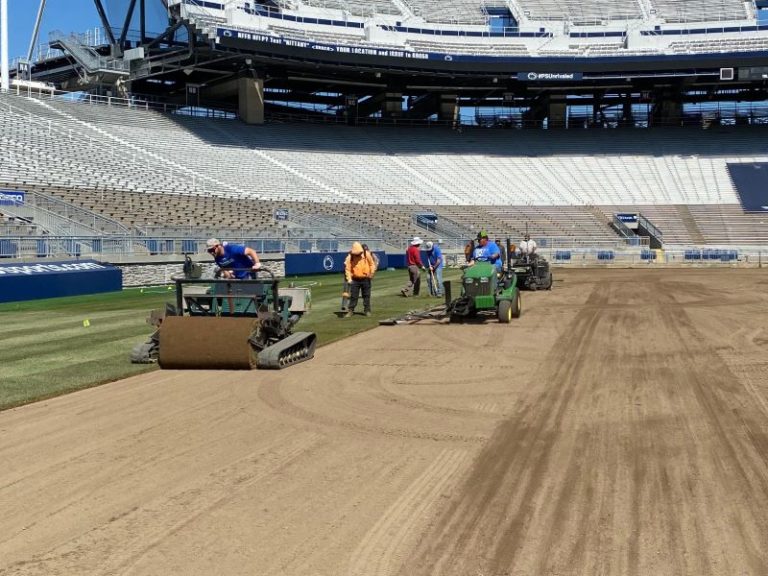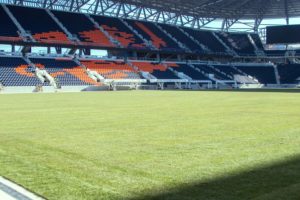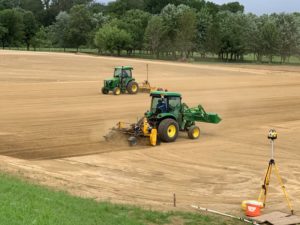By Mary Helen Sprecher
It’s the time of year when fields, having hosted months of practice and games, look rutted, muddy and even skinned in places. Nothing seems to be helping, and the field manager can see a renovation is on the horizon.
The knee-jerk reaction of the owner, though, is to blame the grass or even the builder. After all, the field is made to host sports, right? It logically follows, then, that the turf should be able to withstand use.
Field builders and design professionals say that’s not always the case. A host of problems can be presenting themselves – and it is essential to have an open dialogue about what is happening.
According to Amy Fouty, CSFM, field consultant at The Motz Group, an open dialogue should start upon installation and continue on a regular basis.
“When a field is installed, there are certain expectations regarding the safety and playability of the surface,” said Fouty. “Each end of year (or season), the field should be discussed in terms of these expectations and the amount of maintenance practices being performed on the surface. Sports field managers are stewards of the field and will advocate for the things needed to meet these expectations.”
But there’s another factor that can be just as important, although it is often overlooked in such discussions, said Fouty.
“If activity occurs on the surface that is contradictory to the expectations set, discussion should occur, and additional funds set aside, to mitigate poor outcomes.”
Examples might include a sports field that is also pressed into service to host non-athletic events, such as festivals, concerts or graduations. Make a list of these events and plan well in advance to avoid problems.
According to Brian R. Lee, CFB of Hellas Construction, there are telltale signs – poor drainage, bald spots in the turf and hard pan areas – that point to a field in need of renovation. And at least some of the blame for that, he noted, can be set squarely on a need for better maintenance practices, as well as knowledgeable personnel.
“Field managers need specific time to perform routine preventative measures,” said Lee. “There should also be training for personnel, and proven field superintendents to do or oversee the work being done.”
If funding is tight, however, it’s likely the fields aren’t getting the care – or the attention to detail – they require. That means the steps that are being taken to remedy a problem aren’t necessarily going to be in the turf’s best interest.
And that includes immediately watering the field to try to encourage growth and repairs, said Todd Smith, PhD, PE, LEED AP, of R&R Engineers-Surveyors, Inc.
“Whenever a field ‘stresses,’ the solution seems to be ‘add water.’ When a field thins out or isn’t as green as it was, that’s a sign of stress, but from what? It could be bad soil, too much water causing shallow roots, too much water or too much use causing soil compaction, temperature variations, disease or a number of other things,” said Smith.
Instead of turning on the sprinklers, Smith added, “checking the soil profile and root depth, and other tests of the grass blades should be done to determine the cause and then apply a solution.”
Another important issue, he noted, is to discuss the amount of use the field is getting. Although many schools will adjourn for the summer, the field is often kept busy hosting league play, travel tournaments, combines, college showcases and other sports events. And all that use adds up.
“Overuse is the second-biggest problem,” said Smith. “Natural grass is a living thing and, as such, it needs rest. I often ask clients how many all-nighters they can pull in a row before they can’t function. I then explain grass is also living and needs rest to recharge, uptake nutrients, and repair itself just as humans do. There are many charts and opinions online that take an educated guess on how many different kinds of use the different kinds of grass can take per day. Beyond that, it doesn’t matter what the rootzone, fertilization, overseeding and watering is.”
Additionally, noted Matt Wimer of Hummer Turfgrass Systems, it’s not as though field problems appear full-blown overnight.
“A lot of times an issue will develop over time and worsen until it becomes a safety or playability issue,” said Wimer. “Examples are the middle of a high-use field is getting thinner and thinner year after year as overseeding can’t keep pace with the wear.”
Wimer added that it’s essential to remediate the source of a problem immediately or else it is likely to continue.
“One issue we see a lot of is heavy stands of Poa annua on fields or portions of fields; this is one of the underlying causes of fields not draining well,” he said. “That issue needs to be corrected in order to fix the issue that can be seen, which is the drainage problem. Getting to the root cause of the issue that you can see is something that a sports field contractor can help with.”
But if a field owner is still insisting the field wasn’t built correctly, said Wimer, he or she may just be right – although they may not like the conclusion that is drawn, particularly if the contractor was selected on the basis of a low bid.
“One of the biggest issues with natural grass sports field construction at the high school and small college level is unqualified contractors being hired to perform the initial installation. That is an issue that leads to a lot of post-construction renovations that could have been avoided if the fields were built right from the beginning,” Wimer added.
Working with a contractor who has field-specific experience is an absolute necessity – just as necessary as having a skilled field manager to oversee the facility once it goes in. Finally, the field manager should have ongoing communication with the contractor. If issues crop up, a proactive approach on the part of the field manager and the contractor can help head off problems at the pass.
“The biggest concern in many organizations is often in the areas of the communication, and education, of folks in the organization regarding safety, playability, and maintenance practices needed for the playing surface,” said Fouty. “For any game or match, you need two teams, or two competitors, a ball, and a place to play. This simplistic perspective can often add perspective to discussions if used appropriately.”
Mary Helen Sprecher wrote this article on behalf of the American Sports Builders Association (www.sportsbuilders.org), the national organization for builders, design professionals and suppliers of materials for sports fields, running tracks, tennis courts and indoor and outdoor courts and recreational facilities. It offers several resources to those interested in field construction, maintenance and repair:
Sports Fields: A Construction and Maintenance Manual (2020)
This book promotes the quality construction, maintenance and repair of synthetic turf facilities by providing information to facility owners, administrators, coaches, builders, architects and engineers. The publication is available both in hard copy and via electronic download. For ordering information, go to ASBA’s website, www.sportsbuilders.org, and select the tab on the blue menu bar labeled “Publications.”
ASBA Membership Directory
ASBA offers, free of charge, a directory of its members, categorized by state, as well as by profession. By going to the association’s website, www.sportsbuilders.org, it is possible to access a complete list of professionals available. The directory is in the center of ASBA’s home page, with various search options. A hard copy of the directory can also be requested by calling 866-501-ASBA (2722) or sending an e-mail to info@sportsbuilders.org.




